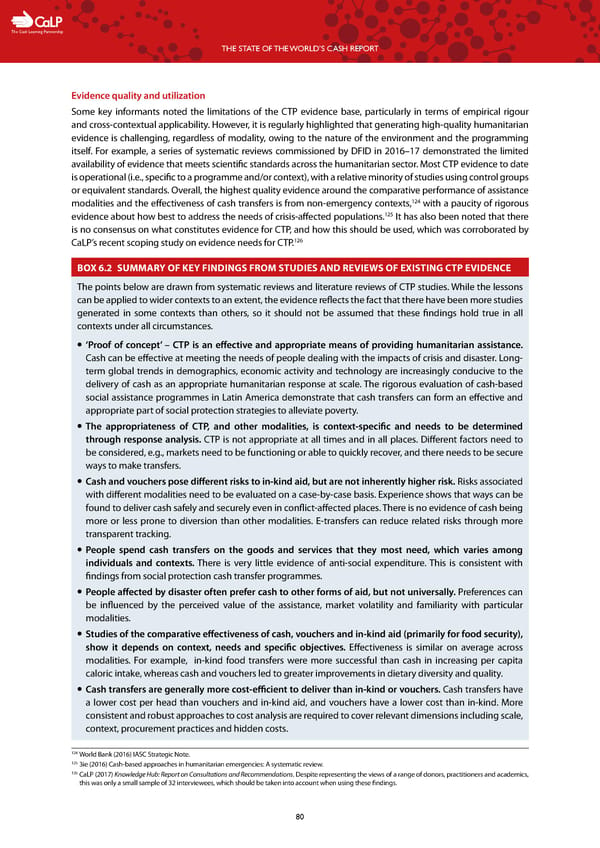C The Cash Learning Partnership THE STATE OF THE WORLD’S CASH REPORT Evidence quality and utilization Some key informants noted the limitations of the CTP evidence base, particularly in terms of empirical rigour and cross-contextual applicability. However, it is regularly highlighted that generating high-quality humanitarian evidence is challenging, regardless of modality, owing to the nature of the environment and the programming itself. For example, a series of systematic reviews commissioned by DFID in 2016–17 demonstrated the limited availability of evidence that meets scientific standards across the humanitarian sector. Most CTP evidence to date is operational (i.e., specific to a programme and/or context), with a relative minority of studies using control groups or equivalent standards. Overall, the highest quality evidence around the comparative performance of assistance 124 modalities and the effectiveness of cash transfers is from non-emergency contexts, with a paucity of rigorous 125 evidence about how best to address the needs of crisis-affected populations. It has also been noted that there is no consensus on what constitutes evidence for CTP, and how this should be used, which was corroborated by 126 CaLP’s recent scoping study on evidence needs for CTP. BOX 6.2 SUMMARY OF KEY FINDINGS FROM STUDIES AND REVIEWS OF EXISTING CTP EVIDENCE The points below are drawn from systematic reviews and literature reviews of CTP studies. While the lessons can be applied to wider contexts to an extent, the evidence reflects the fact that there have been more studies generated in some contexts than others, so it should not be assumed that these findings hold true in all contexts under all circumstances. — ‘Proof of concept’ – CTP is an effective and appropriate means of providing humanitarian assistance. Cash can be effective at meeting the needs of people dealing with the impacts of crisis and disaster. Long- term global trends in demographics, economic activity and technology are increasingly conducive to the delivery of cash as an appropriate humanitarian response at scale. The rigorous evaluation of cash-based social assistance programmes in Latin America demonstrate that cash transfers can form an effective and appropriate part of social protection strategies to alleviate poverty. — The appropriateness of CTP, and other modalities, is context-specific and needs to be determined through response analysis. CTP is not appropriate at all times and in all places. Different factors need to be considered, e.g., markets need to be functioning or able to quickly recover, and there needs to be secure ways to make transfers. — Cash and vouchers pose different risks to in-kind aid, but are not inherently higher risk. Risks associated with different modalities need to be evaluated on a case-by-case basis. Experience shows that ways can be found to deliver cash safely and securely even in conflict-affected places. There is no evidence of cash being more or less prone to diversion than other modalities. E-transfers can reduce related risks through more transparent tracking. — People spend cash transfers on the goods and services that they most need, which varies among individuals and contexts. There is very little evidence of anti-social expenditure. This is consistent with findings from social protection cash transfer programmes. — People affected by disaster often prefer cash to other forms of aid, but not universally. Preferences can be influenced by the perceived value of the assistance, market volatility and familiarity with particular modalities. — Studies of the comparative effectiveness of cash, vouchers and in-kind aid (primarily for food security), show it depends on context, needs and specific objectives. Effectiveness is similar on average across modalities. For example, in-kind food transfers were more successful than cash in increasing per capita caloric intake, whereas cash and vouchers led to greater improvements in dietary diversity and quality. — Cash transfers are generally more cost-efficient to deliver than in-kind or vouchers. Cash transfers have a lower cost per head than vouchers and in-kind aid, and vouchers have a lower cost than in-kind. More consistent and robust approaches to cost analysis are required to cover relevant dimensions including scale, context, procurement practices and hidden costs. 124 World Bank (2016) IASC Strategic Note. 125 3ie (2016) Cash-based approaches in humanitarian emergencies: A systematic review. 126 CaLP (2017) Knowledge Hub: Report on Consultations and Recommendations. Despite representing the views of a range of donors, practitioners and academics, this was only a small sample of 32 interviewees, which should be taken into account when using these findings. 80
 The State of the World's Cash | Full Report Page 81 Page 83
The State of the World's Cash | Full Report Page 81 Page 83